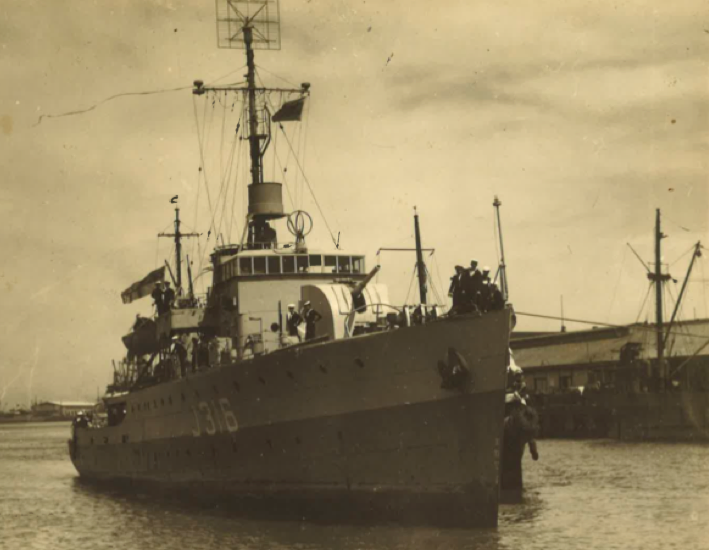HMAS Cootamundra was one of sixty Australian Minesweepers (commonly known as corvettes) built during World War II in Australian shipyards as part of the Commonwealth Government’s wartime shipbuilding programme. Twenty were built on Admiralty order but manned and
commissioned by the Royal Australian Navy. Thirty six including Cootamundra) were built for the Royal Australian Navy and four for the Royal Indian Navy.
HMAS Cootamundra was laid down at Poole and Steel Ltd, Sydney, NSW on 26 February 1942. She was launched on 3 December 1942 by Lady Davidson, wife of the General Manager, Bank of New South
Wales and was the first RAN warship tocarry the name of the town in the South West Slopes region of New South Wales.
Cootamundra commissioned at Sydney on 30 April 1943 under the command of Lieutenant George A Johns RANR(S).
Following a period of trials and working up in the Sydney area, Cootamundra began her wartime career at the close of May 1943, operating as an escort vessel to convoys on the Australian east coast. Japanese submarines were active in these waters, five merchant ships having been sunk in April, and two during May, including the hospital hip AHS Centaur.
On 15 June 1943 Cootamundra proceeded to sea in company with of her sister hips Warrnambool, Kalgoorlie, Bundaberg and Deloraine to escort a
Brisbane bound convoy of thirteen ships. En route off Smoky Cape, New South Wales, the convoy was attacked by Japanese submarines of the 3rd Squadron then operating in Australian waters. Two ships were torpedoed; the Portmar, an United States Army Transport (5551 tons) and a United States Navy Landing Ship Tank, LST 469. The Portmar sank in ten minutes with the loss of two lives, but LST 469, though suffering heavy
casualties (26 were killed and many wounded), remained afloat and was later towed to port.
On 6 July 1943 Cootamundra reached Thursday Island and from there proceeded to Darwin as escort to the merchant ship Aroor. Arriving on 17 July, she began a period protecting the shipping proceeding between that Darwin and Thursday Island. It proved in the main uneventful though arduous duty in the tropical conditions.
On 6 August 1943 Cootamundra was escorting SS Macumba to Darwin when two Japanese aircraft attacked at low level and in spite of anti-aircraft fire from both ships, scored a direct hit on Macumba’s engine room. Attempts to tow the damaged vessel failed and when later the same day it became obvious that Macumba was about to founder, the survivors were taken aboard Cootamundra.
In April 1944 Cootamundra proceeded to Sydney for refit having steamed more than 20,000 miles on escort duty in northern Australian waters and some 28,000 miles since commissioning.
The refit was completed on 31 May. On 3 June Cootamundra proceeded to Darwin where for a brief period she resumed the role of escort vessel. On 28 June she sailed from Darwin escorting SS River Clarence, her last duty as a vessel attached to the Darwin Command. On 1 July, at Thursday Island, she transferred to the administrative and operational control of the Naval Officer-in-Charge, New Guinea. On 5 July she arrived at Milne Bay to begin duty in the forward areas which lasted until the end of hostilities. On 16 July 1944 she sailed from Langemak in company with HMA Ships Rockhampton and Bunbury, escorting her first New Guinea convoy of the war. It was bound for the newly won base at Hollandia.
Convoy escort duty continued through August, and at Aitape on 7 August, her crew witnessed their first bombing of Japanese positions ashore. During the month she visited Mios Woendi, Noemfoor and the recently captured islands of Biak and Wakde.
On 6 September Cootamundra and HMAS Gladstone relieved two American frigates as anti-submarine patrol vessels in the Sansapor area, a duty which kept both ships occupied until the close of the month.
Part 2 Next Week.

